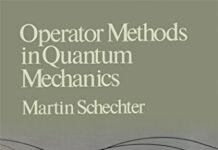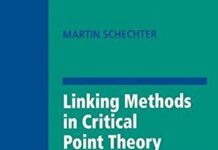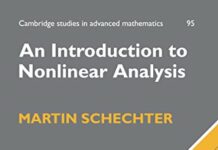
Ebook Info
- Published: 2001
- Number of pages: 425 pages
- Format: PDF
- File Size: 1.57 MB
- Authors: Martin Schechter
Description
Functional analysis plays a crucial role in the applied sciences as well as in mathematics. It is a beautiful subject that can be motivated and studied for its own sake. In keeping with this basic philosophy, the author has made this introductory text accessible to a wide spectrum of students, including beginning-level graduates and advanced undergraduates. The exposition is inviting, following threads of ideas, describing each as fully as possible, before moving on to a new topic. Supporting material is introduced as appropriate, and only to the degree needed. Some topics are treated more than once, according to the different contexts in which they arise. The prerequisites are minimal, requiring little more than advanced calculus and no measure theory. The text focuses on normed vector spaces and their important examples, Banach spaces and Hilbert spaces. The author also includes topics not usually found in texts on the subject. This Second Edition incorporates many new developments while not overshadowing the book’s original flavor. Areas in the book that demonstrate its unique character have been strengthened. In particular, new material concerning Fredholm and semi-Fredholm operators is introduced, requiring minimal effort as the necessary machinery was already in place. Several new topics are presented, but relate to only those concepts and methods emanating from other parts of the book. These topics include perturbation classes, measures of noncompactness, strictly singular operators, and operator constants. Overall, the presentation has been refined, clarified, and simplified, and many new problems have been added.
User’s Reviews
Editorial Reviews: Review “This excellent book provides an elegant introduction to functional analysis … carefully selected problems … This is a nicely written book of great value for stimulating active work by students. It can be strongly recommended as an undergraduate or graduate text, or as a comprehensive book for self-study.” —- European Mathematical Society NewsletterFrom a review of the first edition: “`Charming’ is a word that seldom comes to the mind of a science reviewer, but if he is charmed by a treatise, why not say so? I am charmed by this book. “Professor Schechter has written an elegant introduction to functional analysis including related parts of the theory of integral equations. It is easy to read and is full of important applications. He presupposes very little background beyond advanced calculus; in particular, the treatment is not burdened by topological `refinements’ which nowadays have a tendency of dominating the picture. “The book can be warmly recommended to any reader who wants to learn about this subject without being deterred by less relevant introductory matter or scared away by heavy prerequisites.” —- American Scientist”This is an excellent book e.g. for somebody working in applied mathematics who wants to learn operator theory from scratch. It contains a wealth of material … presented in a very elegant way … book is very pleasant to read.” —- Zentralblatt MATH
Reviews from Amazon users which were colected at the time this book was published on the website:
⭐Well-motivated presentation of the principles of functional analysis. Very different from the typical theorem-proof format. Well done.
⭐Functional analysis is now a vast subject with many applications and this book gives an introduction to this branch of mathematics that can be understood by advanced undergraduates or beginning graduate students. The book fills a gap between elementary aspects of analysis and those using measure theory. The author motivates the subject matter very well, and therefore gives the reader a deeper appreciation of the basics of functional analysis and operator theory. Because of its high quality of presentation, it is very unfortunate therefore that the book is out of print. In chapter 1, the author introduces the subject by considering a particular differential equation, which he solves by the method of variation of parameters. Generalizing the equation leads him finally to the Volterra integral equation, and by abstracting from the properties of this equation he introduces the notion of a Banach space. Several examples of these spaces are given, and he uses them to introduce Hilbert spaces. Appropriately, a discussion of Fourier series concludes the chapter. The Riesz representation theorem, which shows that every bounded linear functional on a Hilbert space can be represented as an inner product, is introduced immediately in chapter 2. This representation is used to motivate a similar question for Banach spaces, namely whether Banach spaces have any nonzero bounded linear functionals. The Hahn-Banach theorem, discussed in detail, shows there are many such functionals. Since there are so many, it makes sense to speak of the space of all of them, called the dual space, which is a Banach space even though the original space may not be. Several examples of dual spaces are given. The author discusses the space of bounded linear operators between normed linear spaces X and Y in chapter 3, showing that it is a Banach space if Y is. The adjoint of an operator is defined, and the author shows why adjoints are useful. The famous Closed Graph Theorem and its geometric interpretation are discussed in detail. Another fundamental result, the Uniform Boundedness Theorem, is proven. Integral equations are also used to motivate the concept of a compact operator in chapter 4, but first via the operators of finite rank. The compact operators are thus the limit in norm of operators of finite rank, and their adjoints are also compact. One of the most important classes of operators of all, the Fredholm operators, are discussed in chapter 5. The author discusses what can be concluded from their definition and gives other criteria for recognizing when an operator is Fredholm. The index theory of Fredholm operators is covered in this chapter, and this is a theory that has far-reaching implications in other areas of mathematics, such as algebraic topology and K-theory. The author discussed briefly a collection of operators called semi-Fredholm operators, that are defined by relaxing some of the conditions for Fredholm operators are relaxed. Spectral theory, also of enormous importance in operator theory, is discussed in chapter 6. The author proves the spectral mapping theorem, explaining the need for complex Banach spaces in this regard. The author shows how to obtain a formula for the inverse of a bounded operator polynomial. The reader will need a background in complex variables in order to follow his discussion here, which has become known as the “operational calculus”. If the spectrum of the operator is disconnected, the author shows how to obtain the spectral projections of the operator. The theory of unbounded operators, typically not treated in beginning books on operator theory, but very important in applications, is discussed in chapter 7. Unbounded Fredholm operators are defined, and the author shows just how much the bounded results can be carried over to these. The same is done for unbounded semi-Fredholm operators. The author returns to Banach spaces in chapter 8, where he discusses reflexive Banach spaces. He proves that a Banach space is reflexive if its dual is, and shows how “saturated subspaces” characterize reflexive spaces. The very important weak* convergence appears here in the discussion of separable Banach spaces. Chapter 9 is the beginning of “soft analysis” wherein the author discusses Banach algebras. The reader gets his first taste of the intertwining of operator theory, algebra, and analysis in this chapter. The “soft” approach to operator theory is vast and is marked by many brilliant developments. Semigroups, so very important in physical applications, are discussed in chatper 10. The discussion again motivated by a differential equation, the author shows clearly the need for strong continuity in obtaining an infinitesimal generator for a one-parameter semigroup of operators. The author returns to Hilbert spaces in chapter 11, wherein he introduces the highly important class of normal operators. He shows that such operators are norm attaining, and proves when normal compact operators have a complete, orthonormal set of eigenvectors. He applies these considerations to a class of (compact) integral operators and then discusses briefly the theory of hyponormal operators. Another topic not usually included in treatments at this level is the theory of bilinear forms, which is done in chapter 12. Very important in many areas of mathematics, the author shows their utility in the context of dissipative operators. He then goes on to the topic of self-adjoint extensions, showing that every densely defined symmetric linear operator has a self-adjoint extension. Self-adjoint opertaors are then treated in detail in chapter 13, beginning with the theory of orthogonal projections, which are very important in applications like quantum physics. He then proves the spectral resolution theorem for bounded self-adjoint operators. The last chapter of the book details some applications, the first few sections dealing mainly with a particular (unbounded) differential operator. Using two different methods the author calculates the spectrum of this operator. He then does essentially the same analysis for a simple integral operator. Both of these operators appear many times in physical applications.
⭐excellent book for self study….no require of measure theory…
Keywords
Free Download Principles of Functional Analysis (Graduate Studies in Mathematics) 2nd Edition in PDF format
Principles of Functional Analysis (Graduate Studies in Mathematics) 2nd Edition PDF Free Download
Download Principles of Functional Analysis (Graduate Studies in Mathematics) 2nd Edition 2001 PDF Free
Principles of Functional Analysis (Graduate Studies in Mathematics) 2nd Edition 2001 PDF Free Download
Download Principles of Functional Analysis (Graduate Studies in Mathematics) 2nd Edition PDF
Free Download Ebook Principles of Functional Analysis (Graduate Studies in Mathematics) 2nd Edition



